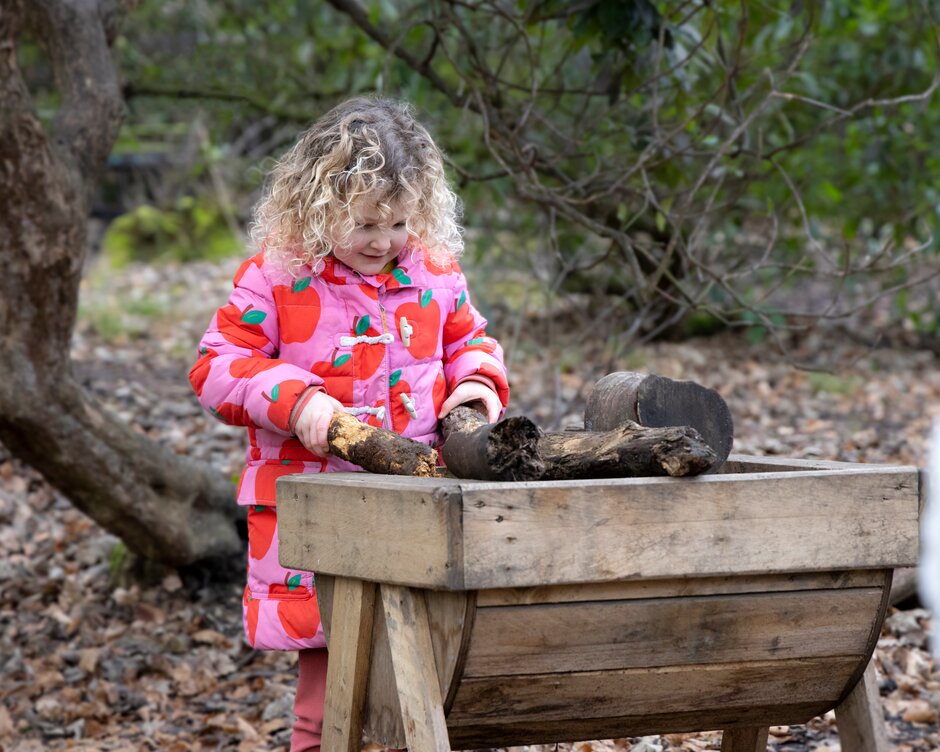Mathematics
This station can be set up indoors or outdoors, but being outside may cause less mess. The loose parts station encourages learners to work together to collect natural objects from an outdoor space, autumn can be a great time to do this. There is a list of objects that adults can gather to place in the loose parts station and a comprehensive guide to help you utilise this space. Loose parts encouraged open-ended play that helps learners to gain a deep understanding of numbers to ten and pattern.
Adult-led Activity Suggestions
- Use the Get It Sorted activity to encourage learners to explore their natural surroundings by collecting natural objects and sorting and classifying them into different groups, allowing children to connect to the natural world and make sense of the world around them.
- 10 ways to measure a tree supports learners to explore measuring objects in the local surroundings through non-standard units of measurement. Learners can try measuring a tree by looking through their legs.
- Everything we use must turn into dirt! This activity is written for older children but can be carried out with Early Years learners by burying a banana peel, leaf, cardboard, a plastic cup or even a pair of pants! Learners can have the opportunity to compare their appearance over a number of weeks. Encourage learners to predict which object will decompose (turn to mud) quickest and which will take the longest. Consider what happens to other forms of packaging after we use them? This can also work as an open-ended enquiry, with learners choosing two objects to bury and check on each week.
- It can rain a lot in the UK and dressed appropriately, puddle splashing is an excellent learning experience. Learners can measure the depth of puddles with a marker on their welly boots or test which equipment is best for transporting water from place to place. Discover more activities with the Puddles Potential guide.
- Investigate how water moves up through a plant. Place celery sticks in water and add different coloured dyes. After a short period of time, you can see the solution moving up through the celery (can be done with white-petalled flowers too)
- Nature Park activity: 3D Model making - using natural materials (or craft materials) to create a ‘3D map’, learners are challenged to think about how they can represent different features and spaces, thinking about appearance, scale and distance.
Continuous Provision
Nature's Loose Parts
Loose parts are a great way to connect children to nature in both indoor and outdoor settings.
Natural loose parts can consist of:
- straw
- mud
- pinecones
- sticks
- leaves
- tree slices
- rope
- off cuts
- cardboard boxes
- bamboo canes
- conkers
- other natural objects that children express an interest in
An engaging way to create a loose parts area is to visit a natural green space with children and collect items together. You can explore different objects together and discuss texture, weight, safety, shape and colour. Once your the loose parts area is set up, it can become a child-led space for enquiry learning. When introducing a loose parts zone ensure safe boundaries are established and group expectations are agreed.
Loose parts enable learners to connect to nature and explore number and shape through natural objects. Loose parts can also create time and space to discover wildlife through creating habitat piles, bird feeding stations or nesting boxes and much more.
Green skill development
- creative thinking
- communication

© RHS, Credit: RHS / Lee Charlton
Early learning goal outcomes
- Have a deep understanding of number to 10, including the composition of each number
- Subitise (recognise quantities without counting) up to 5
- Explore and represent patterns within numbers up to 10, including evens and odds, double facts and how quantities can be distributed equally
- Compare quantities up to 10 in different contexts, recognising when one quantity is greater than, less than or the same as the other quantity